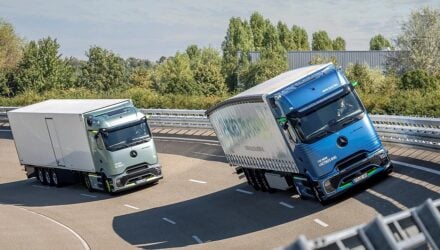To keep water flowing for their customers around North West England, United Utilities relies on a vast operation.
It involves hundreds of reservoirs, treatment works, pumping stations, thousands of kilometres of water pipes and sewers, plus a 5,000 strong workforce. It needs to move these teams around the North West using a wide range of fleet vehicles. They have more than 2,300 vans, cars and trucks, plus 500 specialist plant items.
As an essential community service, vehicles need to be safe to drive and on the road as much as possible, with drivers reaching customers on time and able to react to an urgent situation, such as a burst mains waterpipe.
 As well as keeping customers satisfied, employees safe and business sustainable, United Utilities’ commitment to a 100% Green Fleet by 2028 is very important to the water services company.
As well as keeping customers satisfied, employees safe and business sustainable, United Utilities’ commitment to a 100% Green Fleet by 2028 is very important to the water services company.
How we helped them
Vodafone Business Fleet Analytics, powered by Geotab, offers real-time telematics vehicle performance data.
This helps United Utilities maintenance garages spot if there’s an issue with any of their vehicles ahead of time. The data is used to work with teams to cut idle times (time spent with the engine running but not travelling), to help reduce vehicle wear-and-tear, maintenance, fuel costs and carbon emissions.
It also issues driver behaviour reports that provide drivers with feedback on their driving, including harsh braking, cornering, and speeding for use in improvement training and education programmes.
Better driving also has a positive impact on customer relationships. Stephen Wolstenholme, Head of Fleet, says: “There’s a reputational benefit here. Our vehicles are one of the most recognisable aspects of the brand. It’s important that they’re driven responsibly. It shows that we care about what we do.
“Working with Vodafone is really helping our fleet become sustainable. For us, being able to maximise business efficiencies, protect employees and give our customers a great service, while doing this has been game-changing.”
Carl Doyle, Green Fleet Business Lead, United Utilities said: “Vodafone took the time to understand the challenges that we faced, in switching to an electric fleet – so we could reduce our emissions. Their reports and expertise, helped us to understand what was possible, while making sure changes supported our charging infrastructure – so we could make the right decisions for our business.”
Going electric for a sustainable future
With vehicles replaced every seven years, the business started adding electric vehicles into its fleet to achieve its 2028 100% Green Fleet pledge.
Using data from the Green Fleet Dashboard paired with Electric Vehicle Suitability Assessment data, United Utilities were able to understand:
- Which vehicles to switch to electric:
- Those driven by employees’ who were driving a pool van and living on a property with a driveway.
- How to reduce their carbon emissions:
- By moving their employee’s vehicles from Internal Combustion Engines (ICEs) to electric vehicles (EVs).
- How the change would impact their business infrastructure – they used telematics to understand:
- Dwell times (when a vehicle is stationary at a scheduled stop) to decide how to manage charging infrastructure across their depots.
- Which employees could charge EVs at home and who would need support to do it on-site at work – so they knew where to install their fast and rapid chargers.
Our fleet analytics can help you too
If you feel that Vodafone can help your business, please enter your details in our business fleet website and we will get back to you.
You can Download the United Utilities Case Study, here.



















